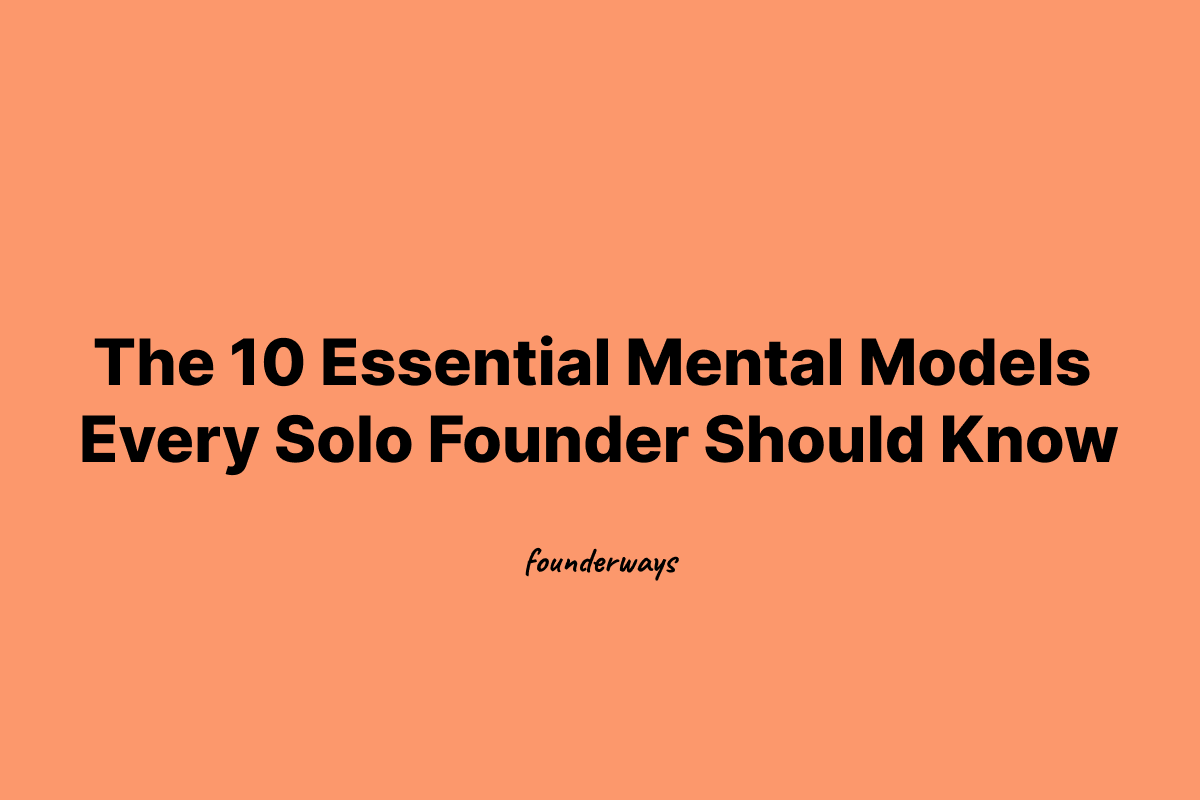The 10 Essential Mental Models Every Solo Founder Should Know

The internet has leveled the playing field.
Anyone with a laptop and an idea can build a business. No investors. No cofounder. No permission needed.
But that doesn’t mean everyone succeeds.
Most solo founders hit the same wall:
- They burn months building products no one wants.
- They chase tactics without strategy.
- They get stuck in indecision and noise.
The difference between those who scale and those who stall?
Not more hours. Not better tools. Not luck.
It’s how they think.
What Are Mental Models—and Why Should Founders Care?
If you’re new to mental models, here’s the short version:
Mental models are how you make sense of the world.
They’re thinking tools. They help you analyze situations, spot patterns, make smarter decisions, and avoid costly mistakes.
And as a solo founder?
They might be your most important asset—because you are your business’s strategist, marketer, product designer, and operator.
Why do mental models matter for solo founders?
Because you’re making dozens of decisions every week:
- What should I build?
- Is this worth my time?
- Why is this not working?
- How do I grow without burning out?
Mental models give you frameworks to answer those questions. They reduce guesswork. They clarify trade-offs. They help you avoid thinking traps like perfectionism, shiny-object syndrome, and decision fatigue.
Are mental models the same as habits or frameworks?
Not exactly.
Here’s the difference:
| Term | What it is | Example |
|---|---|---|
| Habit | A repeated behavior | Posting content daily |
| Framework | A process for achieving an outcome | The 4-step product validation framework |
| Mental Model | A lens for thinking and deciding | First Principles, Opportunity Cost |
Mental models don’t tell you what to do.
They help you think about what to do.
Can I use these models daily?
Absolutely.
The most successful founders use mental models constantly—often without realizing it.
- Choosing whether to launch a new product? → Use Opportunity Cost
- Feeling overwhelmed by tasks? → Use 80/20 Rule
- Wondering if you should pivot? → Use Second-Order Thinking
Mental models won’t give you perfect answers but they’ll lead you to better questions—and that leads to better outcomes.
How do I actually apply them?
You don’t need to memorize them.
You need to practice them.
Here’s how:
- Use the "Ask Yourself" prompts under each model in this post
- Pause before big decisions and run your options through 1–2 models
- Reflect on past mistakes—and see which models you ignored
Bonus tip: Keep a simple journal with your top 3–5 models and revisit them weekly.
Explore the Models
Each of these mental models links to a focused breakdown designed to help you think clearly, prioritize what matters, and move with momentum — without burning out.
- First Principles Thinking
Cut through assumptions and rebuild from what’s true. Make smarter, simpler decisions without the noise. - Opportunity Cost
Every yes is a hidden no. Prioritize the work that moves your business forward. - Circle of Competence
Focus where you’re strongest. Delegate the rest. Grow from your edge — not your ego. - Inversion
Don’t just ask how to succeed — ask how to avoid failing. Clearer strategy. Fewer mistakes. - The 80/20 Rule
80% of results come from 20% of effort. Identify the signal. Cut the noise. - Compound Interest
Small wins, repeated, lead to outsized outcomes. This is how momentum builds — quietly, then suddenly. - Leverage
One piece of work, many outcomes. Turn effort into systems and scale — even solo. - Second-Order Thinking
Think past the first move. Anticipate consequences. Build without regret. - Skin in the Game
Trust advice from people who share the risk. Filter noise. Follow proof, not polish. - The Map Is Not the Territory
Plans are guesses. Feedback is truth. Adapt to reality — not just the roadmap.
Bonus: 3 More Models to Level Up Your Thinking
Here are three more mental models worth adding to your toolbox:
Feedback Loops
What you do today creates results that influence what you do tomorrow. Positive loops build momentum. Negative ones lead to burnout.
Sunk Cost Fallacy
Just because you’ve spent time or money on something doesn’t mean you should keep going. Cut your losses early and move on.
Regression to the Mean
After an extreme win or loss, results tend to return to normal. Don’t chase highs or fear lows. Focus on consistency.
Final Thought: Think Better, Build Smarter
Solo entrepreneurship isn’t about doing everything. It’s about thinking clearly and executing decisively.
Mental models give you leverage.
They help you:
- Focus on what matters
- Avoid common traps
- Build something real and sustainable
You don’t need more tools. You need better questions.
→ Get the full mental model stack
